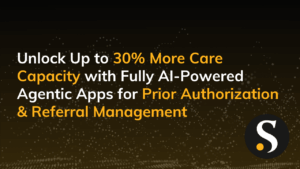AI implementation topped the list of most in-demand business strategies over the last year. Over 37% of organizations report they have implemented AI as part of their strategy.
Everyone seems to be talking about how AI helps them perform tasks in minutes that would take them hours or even days to do manually. Organizations boast about using these technologies to improve cost efficiency and profitability.
Because of all the hype, many organizations are trying to jump on the AI bandwagon. But we’d caution you to take a deep breath and think strategically before you hop on too.
A lot of AI adopters haven’t done the groundwork to be an AI-driven company. Their data is still in Excel files or siloed systems, they don’t understand how a data warehouse fits into the conversation, or they don’t understand exactly how AI is used in business.
As with anything else, you can’t build without a strong foundation.
If you’re thinking AI will instantly deliver more profits, higher efficiency, or better decision-making on a silver platter without investing in a foundational data and technology strategy, you could be in for some unpleasant surprises.
Are you one of those organizations that’s about to jump in the deep end before you know how to swim? It’s gut check time to see if you’re actually ready for AI.
1. You Don’t Know What a Data Warehouse is or Why it Matters
AI is powerful, but it’s not magic.
Contrary to the narrative spreading around right now, AI can’t pull value out of thin air. It needs a library of data to pull from in order to generate insights. A data warehouse is a prerequisite to an effective AI implementation that supports your vision and aspirations.
Teams must also understand how a data warehouse’s mechanics support AI and what it takes to create long-term results. This knowledge ensures that you have the base level knowledge to create an impactful AI program.
Rushing through the implementation before this work is done will leave you underwhelmed by the results and potentially waste money on this costly investment.
2. You’re Not Confident in Your Data Quality
Have you looked at a report or dashboard to see what data you have at your disposal? Does it make sense for your application?
Even if teams have a data warehouse in place, that doesn’t mean that the processes needed to add and normalize data are reliable. This can cause many AI projects to go awry, as the technology behind the AI doesn’t have a reliable set of data to train it and drive results. You need business intelligence (BI) as a way to fact check what your AI is predicting. Without that how can you ever be sure you’re on the right track?
To avoid these mistakes, make sure you have done the proper BI or analysis to be sure of the quality of your data to support the goals of your AI implementation strategy. Make sure you have implemented upstream process or app changes to programmatically have cleaner data.
3. You Don’t Know What You Want to Achieve with AI
When teeing up an AI implementation plan, you should have a narrow and focused scope instead of something broad or vague, like generating more revenue.
The teams that are most successful with their AI initiatives are very clear on what exactly they want to accomplish, and how/if AI can help them get there.
Some common AI goals that you can consider are:
- Increasing revenue by doing X
- Boosting efficiency in X processes
- Increasing personalization
- Anomaly detection to predict before something breaks
You’ll notice that all of these goals are not so broad that they leave results and planning open to interpretation. They involve a clear and specific area in which AI can be applied to help achieve the desired end result.
It’s also worth noting that you don’t want to try to achieve multiple, disconnected goals in the same AI implementation project. This introduces too many variables that can muddy up the steps your organization needs to take. It’s best to break these up into distinct projects.
The more focused your AI implementation strategy is, the more successful the initiative will be.
4. Your Data Doesn’t Have Enough Breadth and Depth
Our monkey brains can only comprehend a limited number of items when we look at a BI report. AI, on the other hand, can layer many different factors simultaneously, find correlations, and see how they influence each other and the outcomes.
If your scope of data is very narrow, it may not be worth bringing AI in to make interpretations, as you may not be using the AI tools to their full potential.
Scant data often produces simplistic answers that may not represent the complete picture. The more extensive your data collection effort is, the more valuable the AI outputs will be.
It’s necessary to take some time before starting your AI implementation journey to build out the database you have, giving AI the opportunity to feed off of more nuanced data.
5. Your Organization Isn’t Ready to Act on AI Outputs & Suggestions
This is where many AI programs break down. Even if you have a data foundation that can support an insight-generating AI machine, it’s ultimately useless if your organization is unable to implement the great insights that you uncover.
First, you must identify the key stakeholders in your business. Who is the team not just accountable for making changes – but for reacting to things like compressor ID4966 is going to break in 20 min. Are they a knowledge worker, a number cruncher, or a part-time worker on the retail floor? How do they know whether to trust it and deploy resources? Do they have a go-no-go process flow?
Consider their ability and interest in applying these insights. Sometimes, this may involve proactively generating buy-in to get them excited about the action items that AI will generate.
Then, you must provide the data via a medium they can use to apply the insights to their daily job duties. The medium could be a report, a mobile app, or an Excel worksheet.
Maximize the Power of AI with Skypoint Cloud
While there’s a lot of pressure to use AI in business, don’t rush into action. A slower, more intentional roll-out will help you achieve the results you want, and this will far outweigh the value of launching a program immediately.
To get the most out of your AI implementation strategy, you must build a solid foundation with a robust data warehouse. Then, identify a focused scope for your initiative and create a BI reporting structure to distribute the insights. Ready to put your data into action with AI? See how Skypoint Cloud has helped organizations implement an effective AI strategy.




